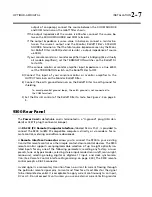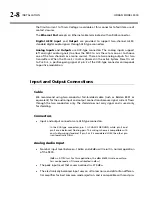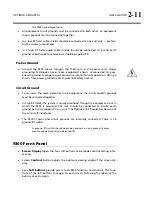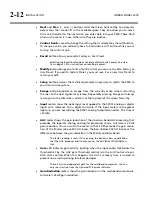
OPTIMOD-AM DIGITAL
INTRODUCTION
1-23
C)
Place the 9300 in bypass mode by remote control.
a)
Switch the 9300 into
BYPASS
mode by a momentary command from your
station’s remote control to the GPI port programmed as
B
YPASS
.
b)
Begin EAS broadcast.
c)
When the EAS broadcast is finished, switch the 9300 from
B
YPASS
mode by
a momentary command from your station’s remote control to the GPI port
programmed as
E
XIT
T
EST
.
You may also choose to insert EAS broadcast tones and data directly into the
transmitter, thus bypassing the 9300 for the duration of the EAS tones and data
broadcast.
PC Control and Security Passcode
PC software control provides access to OPTIMOD-AM via network, modem or direct
(null modem cable) connection, with IBM PC-compatible computers running Win-
dows. PC access is permitted only with a valid user-defined passcode.
PC remote control can be ended from the front panel; this feature effectively pre-
vents simultaneous remote and local control.
Security and Passcode Programming
(starting on page 2-37) for more detail.
Why the North American NRSC Standard?
Over the years, as the North American air waves have become more crowded, inter-
ference from first and second adjacent stations has become more and more of a
problem. Receiver manufacturers responded by producing receivers with decreased
audio bandwidth so that an adjacent station's modulation extremes would not be
audible as interference. This cutting of the bandwidth had the effect of reducing
the receiver's high-frequency response, but it was felt that lower fidelity would be
less obnoxious than interference. As long ago as 1978, Orban proposed and imple-
mented preemphasis and low-pass filtering for AM broadcast to provide brighter
sound at the receiver while minimizing interference. This approach has become
widely accepted. The NRSC-formalized standard is acceptable to all industry seg-
ments, and when implemented, can result in a vast improvement in AM radio.
AM Stereo Introduces a Preemphasis Dilemma
Certain AM receivers manufactured since 1984 for sale in North America, particularly
those designed for domestic AM stereo reception, have a frequency response that is
substantially wider than that of the typical mono AM receiver. The frequency re-
sponse was widened largely to enhance the sales potential of AM stereo by present-
ing a dramatic, audible improvement in fidelity in the showroom. As these new re-
ceivers became more prevalent, broadcasters had to choose whether the station's
preemphasis would be optimized for the new AM stereo receivers or for the existing
conventional receivers that form the vast majority of the market. If the choice was
Содержание OPTIMOD-AM 9300
Страница 1: ...Operating Manual OPTIMOD AM 9300 Digital Audio Processor Version 2 0 Software...
Страница 7: ...Operating Manual OPTIMOD AM 9300 Digital Audio Processor Version 2 0 Software...
Страница 178: ...3 46 OPERATION ORBAN MODEL 9300...
Страница 200: ......
Страница 221: ...OPTIMOD AM DIGITAL TECHNICAL DATA 6 21...
Страница 222: ...6 22 TECHNICAL DATA ORBAN MODEL 9300 CONTROL BOARD PARTS LOCATOR...
Страница 228: ...6 28 TECHNICAL DATA ORBAN MODEL 9300...
Страница 229: ...OPTIMOD AM DIGITAL TECHNICAL DATA 6 29 I O DSP BOARD LEFT AND RIGHT ANALOG INPUTS...
Страница 230: ...6 30 TECHNICAL DATA ORBAN MODEL 9300 I O DSP BOARD ANALOG OUTPUTS...
Страница 231: ...OPTIMOD AM DIGITAL TECHNICAL DATA 6 31...
Страница 238: ...6 38 TECHNICAL DATA ORBAN MODEL 9300 FRONT VIEW REAR VIEW FRONT PANEL PARTS LOCATOR DIAGRAM...
Страница 242: ...6 42 TECHNICAL DATA ORBAN MODEL 9300 NOTES...
















































